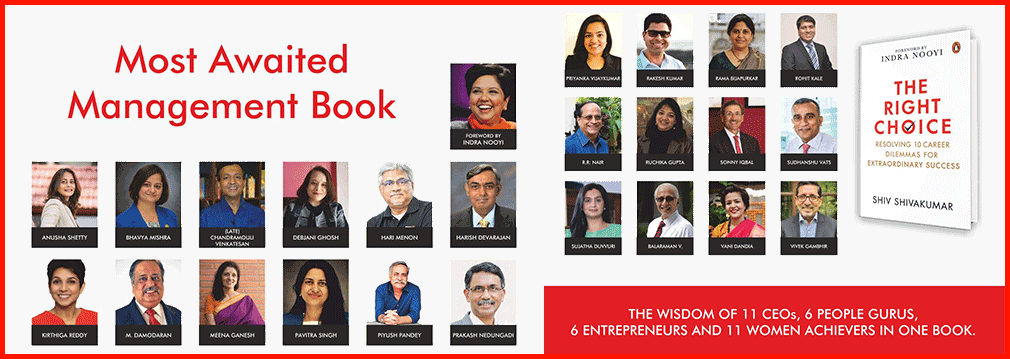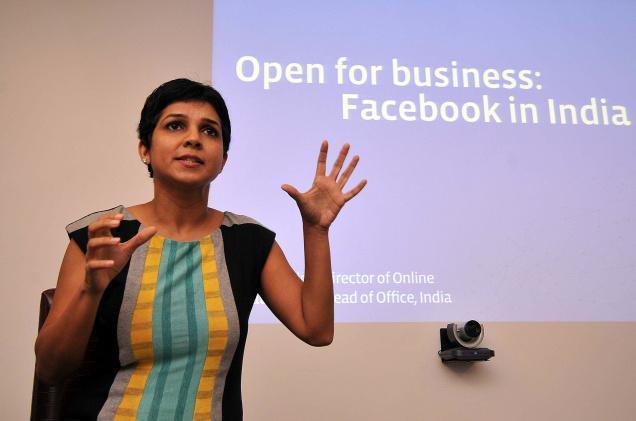
This is an excerpt from the book, The Right Choice by Shiv Shivakumar. Get your copy here.
Q2: a lot of technology employees want to do an MBA but don’t take the plunge. Having been in technology roles plus customer facing roles, what advice would you give them?
I firmly believe that one can do whatever one aspires to with or without an MBA. Mark Zuckerberg, CEO, Facebook, dropped out of Harvard undergraduate program. However, I want to acknowledge that such examples are the exception vs. the rule. Personally, I look back on my MBA experience as transformative. It gave me the skills and the confidence that I could pursue any dream – no matter how big, no matter what field. It also opened doors faster to allow me to prove myself. In my final year of my MBA, I saw a role at Good Technology, a mobile messaging startup, that was compelling. It turned out that the CEO was from Stanford Business School and so was the hiring manager. It was the start of a very fulfilling next six years, leading to the acquisition by Motorola; and my move back to India to lead the Good Technology division in India. My advice: If you start observing growth opportunity from an MBA, lean into it. If you can afford it, don’t sweat about a 1- or 2-year gap in career or income. It is better to regret having done something than to regret not having done something.Q3: you were heading the R and D centre of facebook in Hyderabad and then moved as FB s first India CEO. How did you make that shift, was it easy/difficult to move function and what new capabilities did you need to build.
I was employee #1 and Managing Director of Facebook India and South Asia. The first task was to build Facebook’s operations center in India. It was Facebook’s fourth center. Together, these global centers serve over 3B+ people today who use Facebook’s services. When I joined, trusted advisers asked, “Why move from a product role to an operations role? People usually want to move from operations to product.” My answer: This is Facebook. I believe in the mission, vision and the people. I would do any role for this company! In terms of shifting functions, the best piece of advice I received was from Sheryl Sandberg, COO Facebook. She told me, “Kirthiga, you haven’t risen through the ranks in the Operations organization. Learn the nitty gritty of what the individual contributors do. That’s the foundation to operate effectively at a 20-000 feet level.” At Facebook, I would shadow different parts of the operations organization every week to learn and to keep pace with the evolution. I have taken this to heart in each of my role changes as I learned about new functions, new industries and new cultures – to name a few of the new capabilities I needed to build.Q4: you came to work in India and then went back to the USA. What made you decide to come back to India. What factors contributed to both decisions , moving to india and moving back to the US?
After Good Technology’s acquisition by Motorola in 2007, I used to visit India often to work with the Good India division. I would see how much the country was changing – infrastructure investments, new airports, growing tech ecosystem. When an opportunity came up to lead the Good India division, I applied and was thrilled to be selected. It was a company and product I loved, working with talented people I knew well – I couldn’t ask for more! Dev and I thought we’d move back to India for a year and half and take it from there. I moved first with my two girls, Ashna and Ariya, then 5- and 3-years old. Dev got a 6-month relocation approved and joined me 6-months later. At the end of the first year, we knew we wanted to stay longer. I joined a turnaround company Phoenix Technology. Just as the sale of the divisions I was part of was completing, Facebook announced its intention to open an office in India. When my girls were to start high-school (9th grade) and middle-school (6th grade), we felt that if we ever wanted to move back, that was the right window. It was a well-planned, year-long transition.Q5: you moved from facebook to Softbank Investment Advisers, again here, what shifts in capabilities were needed and how did you manage it?
I joined SoftBank Investment Advisers (SBIA), the Manager of the $100B+ SoftBank Vision Fund, as their first female Investment Partner. My focus is Frontier, Enterprise and Health Tech. My career leading up to my current role was about leading technology transformations – high performance computing with SGI, the mobile shift with Good Technology and the social shift with Facebook. As Deep Nishar, Sr. Managing Partner, SBIA, highlighted when I was considering the SBIA opportunity, my current role allows me the opportunity to be “part of several technology transformations at the same time” and see the impact on people, communities and economies. In terms of shifts in capabilities and how I managed it, it was a two-fold process. One was leveraging my strengths like the know-how of what it takes to scale global businesses, having led multi-$100M businesses. The other was to go deep into all that I needed to learn – new industry, new investment sectors, new culture. I am grateful for my time at Stanford Business School that has given me a deep love of learning, the advice from Sheryl to understand the nitty gritty of the role, and the support from Deep and my colleagues who deeply invested in me.Q6: You are on a few boards, a dilemma people have is how to choose a board role. What factors do you consider when you pick a board role?
I look at three fundamental factors for anything I do, including board roles: Is it a bold mission that I believe in? Are there people I can learn from? Do I bring expertise to be a game changer towards the mission? This framework helps with next-level questions. Public vs. private board? Academic board or, more broadly, non-profit board? Is it in an industry where you bring domain expertise? Or outside industry of expertise where you bring your functional skills? What Board culture would you thrive in? The answers are very individual. To be complete in the assessment criteria, be aware of the liabilities associated with being on the board. Once on a Board, invest in the onboarding phase. If this is your first board, learn about the role and responsibilities of being a board member. If it’s a new industry, learn about the industry. Invest in relationships with the executive team and the rest of the board. Understand key near- and long-term strategic decisions. Understand the difference between accountability as an operating executive vs. the guidance and governance responsibility as a board member. Finally, if not already a practice, be sure to advocate for annual board assessments!






